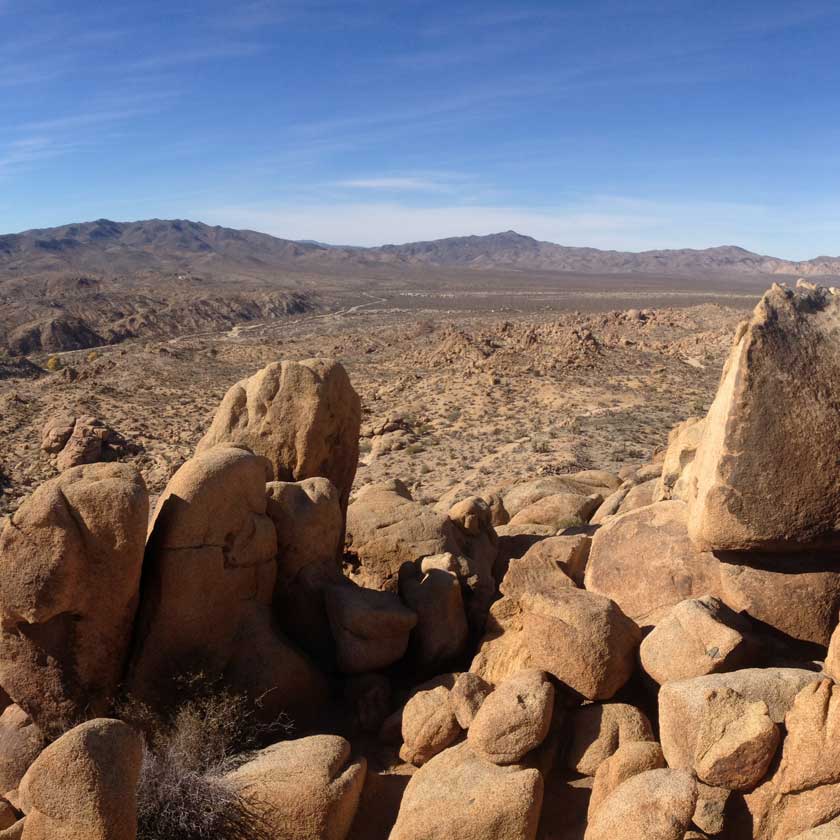The trailhead is located seven miles from the southern entrance to the park, off I-10. Drive past the cottonwood visitors center and cottonwood campground to the terminus of the road. A large parking area and backcountry registration board serves as the starting point to Lost Palms Oasis.
The trail begins by dropping into Cottonwood Springs Oasis. This collection of fan palms and cottonwoods is a popular roadside stop as people enter the park. While you pass the spring, look for two bedrock mortars that native Cahuilla people used to grind mesquite beans into flour. Continue for 0.7 miles to a junction with Mastodon Peak Trail.
From here, most of the crowds will turn off towards Mastodon Peak. I’d highly recommend taking this trail if you have the energy for an additional 1.3 miles on the way back.
The route to Lost Palms Oasis follows a series of rolling hills and washes. The untrained desert eye might consider the majority of this hike fairly monotonous. You’re in the Colorado Desert, sitting much lower in elevation than the Mojave Desert where joshua trees live. This hike is a great opportunity to appreciate some of the lower level flora, such as the ocotillo, jojoba, and smoke tree. Visitors in March will be greeted with a beautiful display of desert blooms along the way.

Ocotillo (pictured), smoke tree, and jojoba are a few of the classic Colorado Desert plants you'll see along this hike
After 1.1 miles, the trail crosses two arms of a large sandy wash. On the second arm, look for a dense grove of smoke trees before exiting the wash. Continue another 1.4 miles over rolling desert hills.

Low rolling desert hills on the way to Lost Palms Oasis
At 2.5 miles, the trail traverses a series of five shallow canyons. Drop into a wash and follow it for 0.1 miles before exiting and climbing to the high point of this route. Monzogranite cliffs begin to close in as you descend over another 0.7 miles. You might catch a glimpse of the nearby Salton Sea as you go.

The Lost Palms Oasis trail just before it enters a shallow canyon
At 3.2 miles the trail drops into one final canyon, continuing for 0.4 miles, and emerging onto a small plateau overlooking Lost Palms Oasis and Dike Springs.

The final canyon before Lost Palms Oasis
This is a good place to stop if you are not comfortable with scrambling, route finding, and off trail travel. To descend into the canyon, look for a social trail the drops down to the north just before you reach the overlook plateau.

The overlook is a good stopping place if you don't want to scramble
The collection of over 100 fan palms at Lost Palms Oasis is widely considered the best of the six oases in Joshua Tree National Park. Navigate your way through the lush palms, which can grow to be over 80 feet tall and live up to 90 years. As the palm fronds die they lay down against its truck, providing shade for the tree and habitats for insects, birds, and small rodents. The densest cluster of palms is located at the top of the canyon, but Lost Palms Oasis stretches down canyon for another 0.3 miles.

Enjoying the shade of Lost Palms Oasis
For a side adventure, consider scrambling up to Dike Springs -- an 800-foot scramble past a small cluster of palms to the northeast. Dike Springs has one dense circle of fan palms that are aligned in a near-perfect ring.
A second of the park oases, Victory Palms, is located another 0.9 miles (one-way) down Lost Palms Canyon. Unless you’re keen on visiting all the parks oases, I’d recommend spending your time at Lost Palms Oasis and Dike Springs instead of venturing to Victory. Victory Palms has a set of two large and a few younger palms. To reach it, continue down the sandy canyon until you reach a massive boulder field. Victory Palms is visible on the other side of this boulder field.
Relax in the shade, listen to the wind through the palm fronds, and watch for the wildlife (perhaps even bighorn sheep!) that make their homes here. When you’re ready, return the way you came and consider the Mastodon Loop trail on the way back for an easy peak climb and views of an old mining site.



